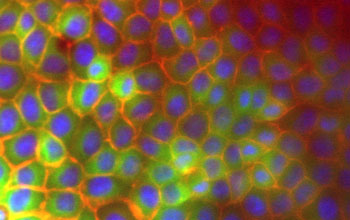Multimedia Gallery
Epithelial cells are imaged on a custom strain array device developed to stretch cells.
Epithelial cells are imaged on a custom strain array device developed to stretch cells for an EFRI project at Stanford University. This project will investigate mechanical interactions between cells that are instrumental to basic processes of life and yet remain poorly understood. In multicellular tissues, the effects of mechanical forces such as stress and strain are focused on junctions that connect the cells together. The team will create novel engineering devices to visualize and characterize how junctions between living cells change as force is applied. They will also use a new class of molecular force sensors to directly visualize the transmission of molecular-scale mechanical force through cell junctions. With these methods, devices and probes, this project aims to transform understanding of the thresholds and mechanisms for environmental adaptation and remodeling of multicellular systems.
Credit: Joo Yong Sim, Nicolas Borghi, James Nelson and Beth Pruitt, Stanford University
See other images like this on your iPhone or iPad download NSF Science Zone on the Apple App Store.
Images credited to the National Science Foundation, a federal agency, are in the public domain. The images were created by employees of the United States Government as part of their official duties or prepared by contractors as "works for hire" for NSF. You may freely use NSF-credited images and, at your discretion, credit NSF with a "Courtesy: National Science Foundation" notation.
Additional information about general usage can be found in Conditions.
Also Available:
Download the high-resolution JPG version of the image. (255 KB)
Use your mouse to right-click (Mac users may need to Ctrl-click) the link above and choose the option that will save the file or target to your computer.
Related story: Insights From Biological World to Inspire New Engineering Capabilities



